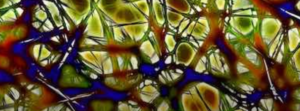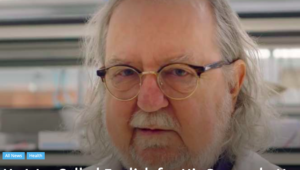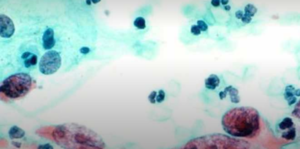Prior to med beds and other medical breakthroughs being introduced, terrestrial scientists are making their medical breakthroughs.
beds and other medical breakthroughs being introduced, terrestrial scientists are making their medical breakthroughs.
Who knows who is inspiring them?
After Her Years of Research, a Cambridge Scientist Could Be on the Verge of Curing Multiple Sclerosis
Jennifer Zolper, Good news Network, Aug 25, 2019
httpss://www.goodnewsnetwork.org/cambridge-scientist-could-be-on-verge-of-curing-ms/
Auto-immune diseases like multiple sclerosis (MS) occur when the body’s immune cells attack healthy tissues. In the case of MS, the cells target the protective layer surrounding the nerves. While the reason for this happening is still unclear, a new medical breakthrough has opened the door to reversing any autoimmunity—and even repairing old damage.
Dr. Su Metcalfe, senior research associate at Cambridge University, discovered a switch within the immune cell that could be “reset” in order to return it to its normal activity.
One of the major elements of her promising pre-clinical trial research involves the leukemia inhibitory factor (LIF): a small signaling protein that acts on stem cells in the body.
“[LIF] is able to activate these cells in order to replace damaged cells during tissue repair—for example, repair of a torn muscle,” says Metcalfe. “A further key role of LIF is to sustain a healthy central nervous system, protecting nerves and maintaining myelin.”
In 2013, she founded the Cambridge company LIF-NanoRx to further the research. Her idea was to guide a measured dose of the tiny, specialized particles to damaged nerves and repair them. However, when the LIF particles were deployed as a therapeutic agent, she found that the body broke down LIF after only 20 minutes.
Enter ultrafine nanoparticles. ‘Nano’ simply refers to the very small size. They’re so tiny that the surface area is much greater than their mass—and they actually have their own name to differentiate them from mere clumps of atoms. Their special properties and size make them uniquely suited to delivering therapies to the interior of cells.
Dr. Metcalfe brilliantly sourced nanoparticles using the same type of material as dissolving stitches. She combined them with the LIF protein to extend the life of the repair agent in the body—and thus far, her testing has been very successful.
Not only does the LIF have time to reach the damaged areas and work their magic, the nanoparticles eventually dissolve within the body, leaving behind only carbon dioxide and water.This means that Metcalfe’s “double whammy” treatment can reverse autoimmunity while simultaneously repairing the damage it has wrought on a patient’s brain.
(Read more…..)
 He Was Called Foolish for His Research; Now Documentary Tells How He Won Nobel Prize for ‘Cancer Cure’
He Was Called Foolish for His Research; Now Documentary Tells How He Won Nobel Prize for ‘Cancer Cure’
McKinley Corbley, Good News Network, Apr 14, 2019
Jim Allison has been the quiet hero behind some of the most ground-breaking medical research of the last quarter century—but before he won the Nobel prize for his work, he was laboring tirelessly to proves his theories against a skeptical scientific community
Back in the 90s, Allison was called “foolish” for claiming that the immune system could fight off cancer. Despite being shot down time and time again by medical researchers and pharmaceutical companies, Allison developed the basis for immuno-oncology drugs – also known as “lpi.”
Allison first became inspired to research cancer treatments as a result of his mother passing away after a long and debilitating battle with lymphoma when he was just 11 years old. After his mother’s passing, Allison would go on to lose a brother and two uncles to cancer; and he himself would end up beating cancer three different times.
(Read more….)
 New ‘Trojan Horse’ Cancer Drug Successfully Treats Patients With 6 Different Kinds of Lethal Tumors
New ‘Trojan Horse’ Cancer Drug Successfully Treats Patients With 6 Different Kinds of Lethal Tumors
Good News Network, Feb 17, 2019
httpss://www.goodnewsnetwork.org/trojan-horse-drug-treats-patients-with-6-kinds-of-cancer/
A brand new type of cancer drug that acts as a “Trojan horse” to get inside tumor cells has shown promise in patients with advanced, drug-resistant cancers.
Patients with six different cancer types, including those with cervical, bladder, ovarian and lung tumors, have responded positively to the new treatment.
Since these patients had already exhausted their other treatment options, the drug could be ready to extend their lifespans within the next five years.
The innovative new drug, called tisotumab vedotin (or TV for short), releases a toxic substance to kill cancer cells from within. The results have been so positive, the drug has now moved forward to phase II trials in cervical cancer and will be tested in a range of additional solid tumor cancers.
A team at The Institute of Cancer Research, London, and The Royal Marsden NHS Foundation Trust led a phase I/II global clinical trial of nearly 150 European patients with a variety of cancer types who had stopped responding to standard treatments.
The study was published in The Lancet Oncology and funded by Genmab and Seattle Genetics.
Researchers saw responses in 27% of patients with bladder cancer, 26.5% of those with cervical cancer, 14% for ovarian cancer, 13% with esophageal, 13% with non-small cell lung, and 7% with endometrial cancer (although not in any men with prostate cancer).
(Read more….)
 Surgeons Successfully Implant World’s First 3D-Printed Rib – and They Plan On Doing Even More in the Future
Surgeons Successfully Implant World’s First 3D-Printed Rib – and They Plan On Doing Even More in the Future
McKinley Corbley, Good News Network, Jan 6, 2019
httpss://www.goodnewsnetwork.org/worlds-first-successfully-implanted-3d-printed-rib/
In a world first, surgeons successfully implanted a 3D-printed rib into a hospital patient.
The procedure, which was recently performed at Tokuda Hospital in Bulgaria, used an implant which was crafted out of an FDA-approved material called Nylon 680.
In addition to being drastically cheaper than titanium, the material was used to make the rib in less than 24 hours for the insignificant cost of $114.
(Read more….)

